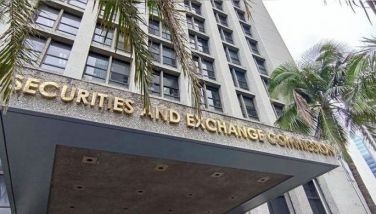Philippines braces for COVID-19 impact
(First of two parts)
MANILA, Philippines — Stock markets across the globe are tumbling, financial business districts around the world are looking like ghost towns and economies are slowing down.
The Philippines is no exception.
In Taguig last Friday, Dec. 6, several offices sent their employees home earlier than usual after the Department of Health reported two more confirmed cases of the new coronavirus disease 2019 or COVID-19 in the country, bringing the number of cases in the Philippines to six as of this writing.
COVID-19-related jitters have sent the stock market spiraling downward, erasing hopes investors initially had for 2020.
Investors had high hopes for 2020 especially coming from a volatile 2018 and a lackluster 2019.
But the new year is looking to be an even more challenging year not only for the Philippine stock market, but also for equities markets across the globe, no thanks to the negative impact of COVID-19.
Investors have reasons to worry. After all, many listed companies are expected to be negatively affected by the virus and report a drop in profits.
According to experts interviewed by The STAR, the virus will affect different sectors – from consumer to property to gaming and tourism to airlines.
Consumer sector
Index heavyweight Jollibee Foods Corp., for instance, temporarily closed its stores in China, which comprised 25 percent of its total China store network or 100 out of 386 stores.
According to RCBC Securities, aside from JFC, other consumer companies will feel the brunt.
These are San Miguel Food and Beverage which has two breweries in Hubei and Shandong provinces in China, and Universal Robina Corp., which also has a manufacturing facility in China is in charge of the local market and also that to other countries in the region.
Property sector
Sy-owned SM Prime Holdings Inc., meanwhile, expects a 10 to 20 percent fallout in average daily mall foot traffic and softer revenue for SM retail in the first quarter of 2020, RCBC Securities said in its report.
Sought for comment, SM Prime president Jeffrey Lim said the company has seven malls in China.
For now, four malls (in Xiamen, Jinjiang, Chengdu and Suzhou), are already back to normal operations while the three others (in Tianjin, Zibo and Chongqing) are awaiting government approval to reopen, Lim said.
But Lim said there is no expected significant impact on SM Prime’s consolidated numbers.
Other mall operators will also likely feel the impact of less foot traffic as a result of the virus. These include Ayala-led Ayala Land Inc., the Gokongweis’ Robinsons Land Corp., Injap Sia’s Double Dragon, Tan-owned Megaworld and Rockwell Land of the Lopez Group, industry sources said.
Tourism and gaming sectors
The same property players also have exposure to the hotel segments and some rely heavily on Chinese clients.
Data culled by RCBC Securities showed that Megaworld’s hotel segment contributes three percent to total revenue. In terms of client base exposure to Chinese tourists, 50 percent of Megaworld’c hotel clients in Boracay are Chinese, data also showed.
Ayala Land’s hotel revenue accounts for four percent of total revenue, while SM Prime’s hotel revenue likewise accounts for four percent of total revenue. Robinsons Land’s hotel business accounts for less than four percent of total revenue.
Bloomberry Resorts Corp, the Razon-owned casino and resorts operator in Paranaque, has a big bulk of Chinese clients – 50 to 60 percent of its VIP clients are Chinese and 30 to 35 percent of gross gaming revenue come from Chinese players, according to data culled by RCBC Securities.
“We are off to a rough start in 2020 as we contend with the tourism impact of an official world health emergency. However, we remain steadfast and aim to demonstrate our resilience by working towards another year of operating excellence,” Enrique Razon said.
Travellers International, a subsidiary of Alliance Global Group, also has significant exposure to Chinese tourists -- five percent of Marriott Hotel’s clientele and 13 to 15 percent of VIP segments gross gaming revenue, data also showed.
Tourist arrivals
China is the country’s second highest source of foreign visitors to the Philippines last year with 1.74 million visitors or a 38.58-percent increase from 2018.
South Koreans are still the top tourists of the country with a total of 1.98 million arrivals or a 22.48 percent growth.
The Philippines had 8.26 million foreign visitors last year, up 15.24 percent from 2018’s 7.16 million international arrivals.
Airlines hardest hit
Of the different sectors, the airline players are taking the heaviest toll.
Lucio Tan-owned Philippine Holdings Inc., operator of four star carrier Philippines Airlines and Gokongwei-owned Cebu Air Inc., the country’s biggest budget carrier operator, are facing turbulent skies.
The two carriers have suspended all flight operations between Philippines and the Greater China route which includes Macau and Hong Kong.
“This route accounts for 13 percent of Cebu Air‘s aircraft capacity. Cebu Air expects average seat load factor to decline from 85 percent to 30 percent on high cancellations and estimates P3 billion to 4 billion in losses should the outbreak extend to six months, based on its experience with SARs in 2003,” RCBC said.
In the case of PAL, the flag carrier has already let go of some 300 employees to mitigate the impact of losses sustained in 2019, aggravated by the ongoing travel restrictions and flight suspensions to areas affected by COVID-19.
MacroAsia Corp., another Tan-led company, may also bear some spillover effects on lower demand for their aviation support, catering, and ground handling services, RCBC also said in its report.
Other industries
Aside from these major industries, many listed firms in several other industries may also be affected.
Consunji-owned Semirara Mining & Power Crop. , for instance, is expected to experience weaker demand from China for coal. This is expected to reduce SCC’s export revenue.
Over the past two weeks, the market has been trading weaker amid increased global risk aversion.
Michael Ricafort, chief economist at Yuchengco-owned RCBC said investors are concerned that the novel coronavirus could lead to slower global economic growth.
He said developments related to the novel coronavirus would still be the major catalyst for the global and Asian financial markets, including the PSEi.
“This would impact on sales, net income, and valuation of some global and multinational companies as well as some affected listed companies that experience some disruptions in operations and in global supply chains,” Ricafort said.
Indeed, the COVID-19 outbreak comes at the worst time possible, adding to negative sentiment brought by recent developments such as President Duterte’s attacks on top conglomerates, the US-China trade spats, the US-Iran conflict, and the eruption of Taal Volcano in January.
These have caused the market to go into a tailspin.
On Feb. 26, the benchmark Philippine Stock Exchange index suffered a heavy blow and slumped to its biggest single day decline since January 2016, and lowest close since November 2018 to finish at 6,909.94, down 277.60 or 3.86 percent.
For this week, the PSEi plunged 114.39 points or 1.66 percent, to close at 6,770.38.
There’s no telling how or when this major health crisis will end, but what is certain is that the negative impact on the stock markets across the globe, including the Philippines will linger long as the virus continues to spread.
“It really depends on how long the cases will grow. If the situation gets controlled and slows down, hopefully, growth in the second half will improve,” said Ed Francisco, president of BDO Capital & Investment Corp.
As crises usually go, things will turn nasty before they get better but for now, everyone – investors included – can only hope that situation improves soon and the crisis ends with the least damage as possible. (To be continued)
- Latest
- Trending


























